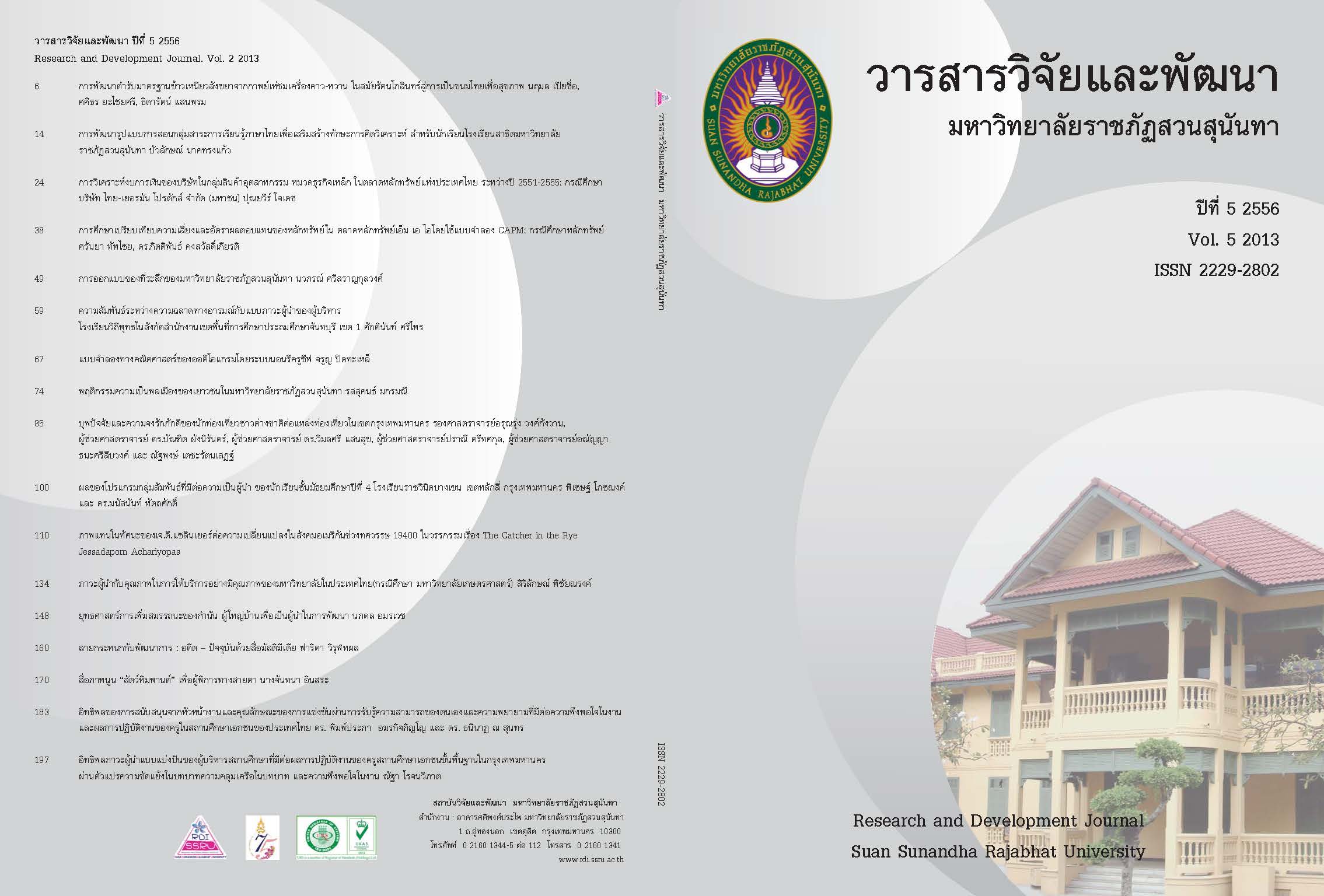ภาพแทนในทัศนะของเจ.ดี.แซลินเยอร์ต่อความเปลี่ยนแปลงในสังคมอเมริกันช่วงทศวรรษ 1940
DOI:
https://doi.org/10.53848/irdssru.v5i1.214317คำสำคัญ:
ภาพแทนการสร้างภาพแทนระบบของภาพแทนความจอมปลอมความแปลกแยกภาวะหดหู่ใจบทคัดย่อ
บทความวิจัยมีวัตถุประสงค์เพื่อวิเคราะห์ตัวละครหลักในนวนิยายเรื่อง The Catcher in the Rye ด้านองค์ประกอบของความคิดและกลวิธีการเล่าเรื่องที่มีอิทธิพลต่อการสร้างภาพแทน และความสัมพันธ์ระหว่างภาพแทนกับความคิดของเจ.ดี. แซลินเยอร์ต่อความเปลี่ยนแปลงในสังคมอเมริกันช่วงทศวรรษ1940 กรอบแนวคิดที่ใช้ประกอบด้วยสองทฤษฎี ได้แก่ ทฤษฎีภาพแทน และทฤษฎีการเล่าเรื่อง นอกจากนี้การวิจัยยังมีเจตนาตอบคาถามสามประการ ประการแรกการผลิตความหมายผ่านภาษาในวรรณกรรมเรื่อง The Catcher in the Ryeถูกสร้างขึ้นอย่างไร ประการที่สอง ทัศนะของเจ.ดี.แซลินเยอร์ต่อความเปลี่ยนแปลงในสังคมอเมริกันช่วงทศวรรษ 1940 คืออะไร ประการสุดท้าย ความสัมพันธ์ระหว่างภาพแทนกับทัศนะของเจ.ดี. แซลินเยอร์เป็นอย่างไร
ผลการศึกษาพบว่าทัศนะของตัวละครหลัก ทัศนะของเจ.ดี. แซลินเยอร์ และความเปลี่ยนแปลงในสังคมอเมริกันช่วงทศวรรษ 1940 มีความเกี่ยวข้องสัมพันธ์กันโดยเด่นชัด การสร้างภาพแทนของตัวละครหลักถูกสร้างผ่านกลวิธีการเล่าเรื่อง ทัศนะของเจ.ดี. แซลินเยอร์ต่อความเปลี่ยนแปลงในสังคมอเมริกันช่วงทศวรรษ 1940 เป็นทัศนะเดียวกันกับทัศนะของตัวละครหลัก ได้แก่ ความจอมปลอม ความแปลกแยก และภาวะหดหู่ใจ
เอกสารอ้างอิง
[10] Salinger, J.D. The Catcher in the Rye. New York: Back Bay Book; 2001. p.3. [11] Steinle, Pamela Hunt. In Cold Fear: The Catcher in the Rye Censorship Controversies and PostwarAmericanCharacter. Columbus. OhioStateUniversity Press; 2000. p.3. [12] Hall, Stuart. Representation: Cultural Representations and Signifying Practices. London. SAGEPublications Ltd; 1997. p.16. [13] Dormann, S. The Catcher of Zero Existentialism in Contemporary U.S.- American Literature. (2011, February 7) Retrieved from http://othes.univie.ac.at/8077/1/2010-01- 12_9604310.pdf [14] Howe, A. Undressing J. D. Salinger: Fashion and Psychology in The Catcher in the Rye and“Teddy ”. (2011, January 22). Retrieved from http://www.georgiasouthern.edu/ etd/archive/spring2008/alicia_v_howe/ howe_alicia_v_200801_ma.pdf[15] French, Warren. The Catcher in the Rye and David Jerome Salinger. (2011, December 17) Retrieved from http://www.directessays.com /viewpaper/54215.html
[16] Iduncanoo. Why did the catcher in the rye have such and impact on Americans of the 20th century and today? (2011, December 12) Retrieved from <http://answers.yahoo.com/ question/index?qid=20080825171231AAqIThs >, p.1
[17] Litcharts. The Catcher in the Rye: Background Info. (2011 November 6)Retrieved from<http://www.litcharts.com/lit/ thecatcherintherye/backgroundinfo>, p.1
[18] Wikipedia. J.D. Salinger. (2011, November 11) Retrieved from <http://en.wikipedia.org/ wiki/J._D._Salinger>, p.4.
ดาวน์โหลด
เผยแพร่แล้ว
รูปแบบการอ้างอิง
ฉบับ
ประเภทบทความ
สัญญาอนุญาต
บทความที่ได้รับการตีพิมพ์เป็นลิขสิทธิ์ของ สถาบันวิจัยและพัฒนา มหาวิทยาลัยราชภัฎสวนสุนันทา
ข้อความที่ปรากฏในบทความแต่ละเรื่องในวารสารวิชาการเล่มนี้เป็นความคิดเห็นส่วนตัวของผู้เขียนแต่ละท่านไม่เกี่ยวข้องกับมหาวิทยาลัยราชภัฎสวนสุนันทา และคณาจารย์ท่านอื่นๆในมหาวิทยาลัยฯ แต่อย่างใด ความรับผิดชอบองค์ประกอบทั้งหมดของบทความแต่ละเรื่องเป็นของผู้เขียนแต่ละท่าน หากมีความผิดพลาดใดๆ ผู้เขียนแต่ละท่านจะรับผิดชอบบทความของตนเองแต่ผู้เดียว





